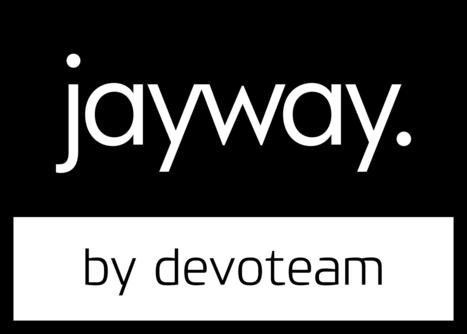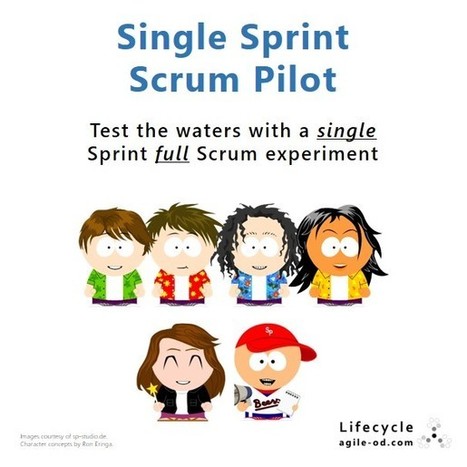 Your new post is loading...
 Your new post is loading...
So how does this work out? At MySpace all groups achieved exit. All, but one, improved after that. One group even achieved a whopping 1,650% improvement after just four months (16 sprints). At Jayway one of the teams used such a bootstrap technique, primarily on the technical side, and reached 800% after 3 months.
The second part of this blog can be found here: Scrum Shock Therapy, Part 2 where I will look into how to handle management and organisation with some recipes.
In a show of hands, half the people in the room doing Scrum admit to passing the first 3 questions of the Nokia Test.
Only 10% of teams meet all criteria. (I'd say only one of our two teams is currently doing this)
Even ScrumButt brought a measured 35% benefit to teams using it.
Challenges for new agile developers:
They can't self-organise.
They spend weeks arguing about the format of the board and get nothing done.
They don't follow priorities - everyone does their own thing and the sprint fails.
They can't get DONE at the end of the sprint.
They allow not-READY things to enter the sprint.
They can take years to work this out. Some don't.
As investors, Jeffs VC group invests only in Scrum+XP companies. Scrum is driven at board level. Many run management team, marketing, client services and support with Scrum.
What's the secret sauce? They want to change the face of investment in the US.
Implement basic Scrum practices and pass Nokia tets
Involve management, understand velocity
Some companies see 300% improvement in 3 2-week sprints - it used to take years.
Waterfall : 2 function points/dev pcm.
Scrum: 17.8 function points/dev pcm (w/ Mike Cohn test)
SirsiDynix: linearly scalability of a distributed team, 15.3 function points/dev pcm with team split between Moscow and US.
Xebia: half the team in Holland, half India. 15.1 function points/dev pcm. Their definition of "done" is the customer doing acceptance tests and judging complete before the end of a sprint.
Takes MySpace as an example: 1/3 of the company is waterfall, 1/3 ScrumButt, 1/3 Scrum. They have hundreds of developers, owned by Fox News, have founders running development. Management doesn't understand Agile and isn't committed. They brought in 30 project leaders who tried Scrum and thought it was "getting in the way of controlling projects". They've been trying to get rid of it.
They've tried "shock therapy": a set of good practices, but no choice. In agile, we want self-managing teams, but when the team doesn't know how to do this there's a problem.
Leadership changes from directing (telling the team) to coaching (involving the team) to supporting (team takes the lead) to delegating (team does it all). The goal of a Scrummaster is to work themselves out of a job as fast as possible.
Shows Aikido picture.
It's like learning the tango. You need a coach. "There are many of us in agile practice who have worked in martial arts, and there are lots of similarities".
Scott at Myspace takes 2.9 days per team member to improve team velocity by 240%. He's not necessarily popular!
Scrum as a framework gives teams lots of options. In practice, this overwhelms many teams. Just as customers don't know what they want, many agile teams don't know what to do til they're doing it. Scott's rules stay in effect until a team meets their goals for 3 sprints.
S’il n’existe pas de modèle parfait pour manager une équipe, les comportements autoritaires et dont l’aspect hiérarchique est fortement marqué …
|
Sprint Backlog Commitment is the final act of this Ubermeeting. In the first few Sprints, I literally read aloud what "Commit" does and does not mean so that there is no doubt in anyone's mind. Once the team commits to the work, the meeting adjourns.
During the Sprint, Multi-Tasking is Forbidden. Work must be in addressed and completed in Priority Order.
Some Engineers understand this right away. Others feel most productive or fulfilled when they have multiple projects in progress. They don't appreciate my pointing out that there is no value in incomplete work – but point it out, I do. Often.
I insist and enforce that they work on cards without multi-tasking and in priority order. Sometimes this leads to petulant protests with people sitting idle but they’re doing less damage in that mode than with their hands in nine projects, none of which will be done.
It's easy to get started with Scrum, but a lot can go wrong. Test the waters with a compact, single Sprint Scrum pilot experiment.
|
 Your new post is loading...
Your new post is loading...
 Your new post is loading...
Your new post is loading...















